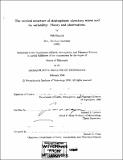The vertical structure of stratospheric planetary waves and its variability : theory and observations
Author(s)
Harnik, Nili, 1969-
DownloadFull printable version (20.90Mb)
Other Contributors
Massachusetts Institute of Technology. Dept. of Earth, Atmospheric, and Planetary Sciences.
Advisor
Richard S. Lindzen.
Terms of use
Metadata
Show full item recordAbstract
Observations of the vertical structure of stratospheric planetary waves reveal a large variety of structures, and a variability both on seasonal and on daily time scales. The extent to which linear wave theory explains these structures and their time evolution at a given time or season is not well known. The sensitivity of linear wave models to details of the basic state and model damping, both of which are not determined from observations in great accuracy, makes it hard to determine why the observations deviate from modeled waves in any given case. In addition, the ability of the observations to resolve the vertical structure of planetary waves is not obvious, given the low vertical resolution of satellite retrievals. The goal of this thesis is to understand the sources of observed variability of vertical wave structure, in particular, to determine whether linear wave theory can explain this variability, and whether the observations are capable of resolving it. We start by testing the ability of satellite retrievals to resolve the vertical structure of the waves. We calculate the radiances that a virtual satellite sitting at the top of our model atmosphere would see, and invert them to obtain retrieved temperature fields. The comparison to the model temperatures suggests that the retrievals are able to resolve their general features quite well, with a few exceptions. Above 1.5mb there is little observed information in the retrievals, and errors start growing above 5 mb. Also, small scale features are not resolvable, but most waves have large enough vertical wavelengths to be resolved. We also identify dynamic situations in the real atmosphere which are more prone to retrieval errors. These are mostly relevant to summer or to the breakup of the polar vortex, when the existence of critical surfaces may cause the waves to have sharp features. The next part consists of understanding the relation between vertical wave structure and the wave propagation characteristics of the basic state in a series of linear wave models, both steady state and time dependent. We study the normal modes on a one dimensional (vertical) troposphere-stratosphere system, using a framework of wave geometry, which allows us to generalize the results to many basic states. A large variety of vertical wave structures is found, similar to observed. This variety is due to the existence of stratospheric turning points. We extend these results to basic states that vary in latitude and height in a nonseparable way. The main problem is how to separate the wave propagation into the vertical and meridional directions. Our approach is diagnostic, where we calculate meridional and vertical wavenumbers from the steady state wave solution to a given basic state, and use them as a diagnostic of the basic state wave propagation characteristics. In particular, we are able to determine the location of turning surfaces for meridional and vertical propagation. By applying this wavenumber diagnostic to many model runs we show that the existence of a stratospheric waveguide renders the problem qualitatively one dimensional by determining the meridional wavenumber, regardless of the characteristics of the tropospheric forcing. In particular, the effects of damping and turning surfaces on the vertical structure are qualitatively as in the vertical propagation problem. In a complementary study, we regard the waves as consisting of many wave activity packets that propagate from the troposphere through the stratosphere, until they dissipate. A technique that follows a wave packet on its journey through the stratosphere, while keeping track of variations in wave activity that are due to refraction of the waves, is introduced and applied to the model runs. This allows us to separate between the contributions to the wave activity budget of damping, refraction, and time variations in the source of wave activity. Also, we can estimate the time scale for vertical propagation through the stratosphere of specific wave events. Finally, we use our diagnostics to study observed wave episodes. We show that the differences in vertical wave structure between middle and late winter episodes in the southern hemisphere can be explained as a linear response to the seasonal evolution of the basic state wave propagation characteristics. We also show that the occasional daily time scale variations of vertical wave structure within a given wave episode are qualitatively a linear response to time variations of the basic state wave propagation characteristics. Since the basic state variations are wave driven, the relevant theory is quasi-linear. Estimates of wave propagation time scales, obtained using our wave activity diagnostic, are also consistent with the theory. We take this is a qualitative assessment of the applicability of quasi-linear wave propagation theory on daily time scales, as well as an assessment of the observations of the waves and the basic state. The latter is not obvious since most of the relevant variations in the basic state occur above 5mb, where observations are less accurate.
Description
Thesis (Ph.D.)--Massachusetts Institute of Technology, Dept. of Earth, Atmospheric, and Planetary Sciences, 2000. Includes bibliographical references (p. 246-256).
Date issued
2000Department
Massachusetts Institute of Technology. Department of Earth, Atmospheric, and Planetary SciencesPublisher
Massachusetts Institute of Technology
Keywords
Earth, Atmospheric, and Planetary Sciences.